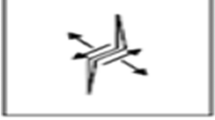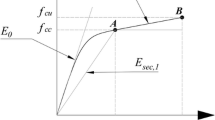Abstract
This paper presents the development of a practical mortar fatigue model on the basis of the dissipated energy concept. A specially designed test setup was developed for characterization of mortar fatigue at meso-scale by means of dynamic shear rheometer. Test results showed that mortar fatigue models based on the dissipated energy concept can be developed for the purpose of life predictions under complicated loading conditions. The dissipated energy per cycle in the initial phase of fatigue tests is a practical indicator for fatigue life determination purposes than the total energy dissipated during a fatigue test. Since a mortar fatigue model based on the initial dissipated energy per cycle was adopted, effects of random stress and strain signals on mortar fatigue can be taken into account.












Similar content being viewed by others
References
Huurman M, Mo LT (2007) Lifetime optimisation tool, user’s guide, Report 7-07-170-5. Delft University of Technology, Laboratory of Road and Railway engineering, Netherlands
Huurman M, Mo LT, Woldekidan MF (2010) Unravelling porous asphalt concrete towards a mechanistic material design tool. Road Mater Pavement Design 11:583–612
Mo LT, Huurman M, Wu SP, Molenaar AAA (2009) Ravelling investigation of porous asphalt concrete based on fatigue characteristics of bitumen–stone adhesion and mortar. Mater Design 30(1):170–179
Mo LT, Huurman M, Wu SP, Molenaar AAA (2007) Investigation into stress states in porous asphalt concrete on the basis of FE-modelling. Finite Elem Anal Des 43:333–343
Mo LT, Huurman M, Wu SP, Molenaar AAA (2008) 2D and 3D meso-scale finite element models for ravelling analysis of porous asphalt concrete. Finite Elem Anal Design 44:186–196
Kocabicak U, Firat M (2004) A simple approach for multiaxial fatigue damage prediction based on FEM post-processing. Mater Design 25:73–82
Sun GQ, Shang DG (2010) Prediction of fatigue lifetime under multiaxial cyclic loading using finite element analysis. Mater Design 31:126–133
Grand YS (1981) Multiaxial fatigue: a survey of the state-of-the-art. J Test Eval 9:165–178
Macha E, Sonsino CM (1999) Energy criteria of multiaxial fatigue failure. Fatigue Fract Eng Mater Struct 22:1053–1070
Aleksander K, Ewald M (2005) A review of critical plane orientations in multiaxial fatigue failure criteria of metallic materials. Int J Fracture 134:267–304
Lagoda T, Ogonowski P (2005) Criteria of multiaxial random fatigue based on stress, strain and energy parameters of damage in the critical plane. Materialwiss Werkstofftech 36:429–437
Lachowicz CT (2001) Calculation of the elastic-plastic strain energy density under cyclic and randon loading. Int J Fatigue 23:643–652
van Dijk W (1975) Practical fatigue characterization of bituminous mixes. J Assoc Asphalt Paving Tech 62:38–74
Pronk AC, Hopman PC (1990) Energy dissipation: the leading factor of fatigue. Highway research: sharing the benefits, proceedings of the conference of the United States Strategic Highway research program, London
Jaeseung K, Roque R, Birgisson B (2006) Interpreting dissipated energy from complex modulus data. Road Mater Pavement Design 7:223–245
Hopman PC, Pronk AC, Kunst PAJC, Molenaar AAA, Molenaar JMM (1992) Application of the visco-elastic properties of asphalt concrete. Proceedings of the 7th international conference on Asphalt pavements, Nottingham
Carpenter SH, Shen SH (2006) Dissipated energy approach to study hot-mix asphalt healing in fatigue. J Transport Res Board 1970:178–185
Ghuzlan KA, Carpenter SH (2006) Fatigue damage analysis in asphalt concrete mixtures using the dissipated energy approach. Can J Civ Eng 33:890–901
Shen SH, Carpenter SH (2005) Application of the dissipated energy concept in fatigue endurance limit testing. J Transport Res Board 1929:165–173
Andrews RM, Brown MW (1989) Elevated temperature out-of-phane fatigue behaviour of a stainless steel. Biaxial, Maltiaxial Fatigue, Publication 3, London
Mo LT, Huurman M, Wu SP, Molenaar AAA (2010) Investigation into material development and optimization of improved ravelling resistant porous asphalt concrete. Mater Design 31:3194
Muraya P (2007). Permanent deformation of asphalt mixes. PhD Thesis, Delft University of Technology, Netherlands
Hagos E (2008) The effect of aging on binder properties of porous asphalt concrete aging. PhD thesis, Delft University of Technology, Netherlands
R. Khedoe, J. Moraal (2008) Sample preparation and laboratory testing for the LOT research program. Report 7-07-170-4, Delft University of Technology, Netherlands
Mo LT (2010) Damage development in the adhesive zone and mortar of porous asphalt concrete. PhD Thesis, Delft University of Technology, Netherlands
Mo LT, Huurman M, Wu SP, Molenaar AAA (2012) Research of bituminous mortar fatigue test method based on dynamic shear rheometer. J Test Eval 40:84–90
Molenaar AAA (2007) Road material: Part III Asphalt materials, Lecture note CT 4850. Delft University of Technology, Netherlands
Miner MA (1945) Cumulative damage in fatigue. J Appl Mech 67:A159–A164
Aid A, Amrouche A, Bouiadjra B, Benguediab M, Mesmacque G (2011) Fatigue life prediction under variable loading based on a new damage model. Mater Design 32:183–191
Acknowledgments
The authors gratefully acknowledge support of the Centre for Transport and Navigation (DVS), Dutch Ministry of Transport, Public Works and Water Management, provided under the project Life Optimization Tool for Porous Asphalt (DWW-2923). The work was also supported by the Fundamental Research Funds for the Central Universities (2012-IV-024), Doctoral Fund of Ministry of Education of China (20110143120013) and the Scientific Research Foundation for the Returned Overseas Chinese Scholars, State Education Ministry. Financial support by Project on the Integration of Industry, Education and Research of Guangdong Province and Ministry of Education (No. 2012B091000162) is also acknowledged.
Author information
Authors and Affiliations
Corresponding author
Rights and permissions
About this article
Cite this article
Mo, L., Huurman, M., Wu, S. et al. Mortar fatigue model for meso-mechanistic mixture design of ravelling resistant porous asphalt concrete. Mater Struct 47, 947–961 (2014). https://doi.org/10.1617/s11527-013-0105-6
Received:
Accepted:
Published:
Issue Date:
DOI: https://doi.org/10.1617/s11527-013-0105-6




